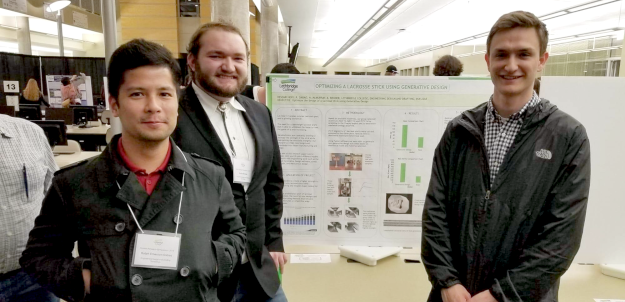
Albertan engineering tech students design near-unbreakable lacrosse stick
By Dale Woodard, Lethbridge Herald
GeneralResilient sports equipment developed using generative design software and 3D printing.

From left: Former Lethbridge College students Ralph Dabao, Austin Bruder and Nathan McMurray.
(Photo Credit: Lethbridge College)
“Two of our group members have played lacrosse for many years and a part of playing lacrosse is having your stick break,” said McMurray, one of his team’s lacrosse players, having played the sport all his life in Lethbridge. “With us being college students, replacing sticks is not the most friendly thing for your pocket. We decided to use the software that we had available at the college and use our skills that we had learned throughout our program and combined them to create the stick.”
The three former students’ findings earned them a prestigious provincial nod with recognition by the Association of Science and Engineering Technology Professionals of Alberta (ASET) as a finalist for the 2020 Capstone Project of the Year Award.
“Our group was shocked and pretty excited,” said McMurray, one of five provincial finalists. “We all are certified members of ASET, so it was quite an honour to be recognized by our professional association.”
The Capstone Awards were established by ASET in 2017 in response to member interest in back-to-school stories about Capstone projects undertaken by teams of engineering technology students from NAIT, SAIT, Red Deer College and Lethbridge College as part of their end-of-program requirements.
Each of the four polytechnics submit two projects for consideration with the students developing projects as part of their second-year requirements.
The submissions are made by the school and program chairs in consultation with the instructors and from those eight maximum entries, the ASET Awards Committee awards one of those projects the ASET Capstone Project of the Year Award. The remaining seven entries are named as finalists.
For the 2020 Capstone Project of the Year, only five submissions were made by the polytechnics with some schools opting to submit only one project.
The group’s goal was to use generative design to develop a high-strength-to-low-weight ratio aluminum stick. They designed, tested and 3D-printed a lacrosse shaft. Due to there being different kinds of aluminum alloy on the market they focused on 2024-T4; 6061-T6 and 7075-T6, the closest to the alloys used by major manufacturing companies.
The team began by breaking existing aluminum lacrosse sticks, using the three-point flexural _ the action of bending or curving, or the condition of being bent or curved — stress to determine maximum loads.
They shaved material on the inside walls of the stick without compromising the structural integrity and outside shape for play. By reducing the thickness of the outside walls and adding intermediate supports throughout the interior of the shaft they were able to increase the strength with only a marginal addition of weight. McMurray, Bruder and Dabao had four months to work with the project.
“We were limited with time as this was a school project,” said McMurray. “But when we did start the project, how we started it was we took existing aluminum lacrosse shafts that we already had and put them through a three-point stress test. The stress test gave us data and we put the data into a 3-D modelling software. It was in that software that we were able to perform different stress analysis tests.
“We were able to perform different tests on the stick just based off what we knew and how a stick would take that impact. That was very helpful calculating different loads and impact points.”
Barry Cavanaugh, CEO of ASET, said he has seen photos of McMurray, Bruder and Dabao’s work.
“They are very innovative young men, there’s no question,” he said. “I think it’s interesting that lacrosse is a national summer sport in Canada and the oldest sport in North America and when I started thinking about that I realized innovation and ingenuity are kind of like the national sport of engineering technology. These are very intense programs they take at Lethbridge College. They can press probably three years of study into two and, as they complete the program, they become eligible to become technologists in training with their organization.
“After they get two or more years of experience in their discipline they can apply for certification and assuming they are successful they will become certified engineering technologists, which opens a lot of doors.”
https://lethbridgecollege.ca
